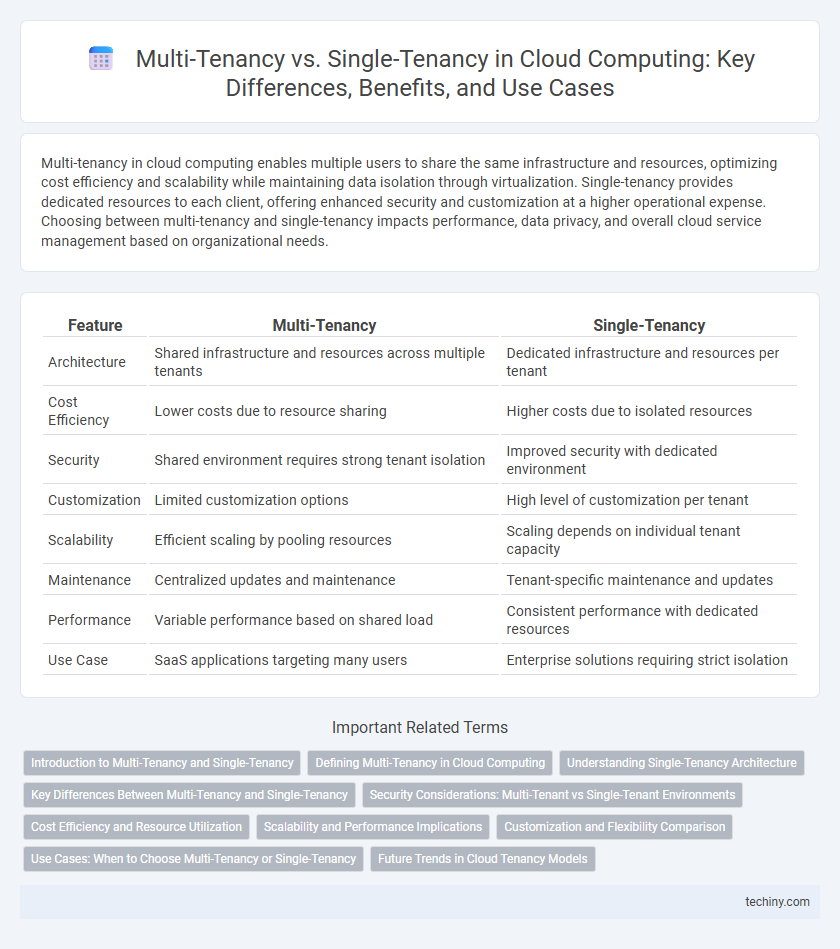Multi-tenancy in cloud computing enables multiple users to share the same infrastructure and resources, optimizing cost efficiency and scalability while maintaining data isolation through virtualization. Single-tenancy provides dedicated resources to each client, offering enhanced security and customization at a higher operational expense. Choosing between multi-tenancy and single-tenancy impacts performance, data privacy, and overall cloud service management based on organizational needs.
Table of Comparison
| Feature | Multi-Tenancy | Single-Tenancy |
|---|---|---|
| Architecture | Shared infrastructure and resources across multiple tenants | Dedicated infrastructure and resources per tenant |
| Cost Efficiency | Lower costs due to resource sharing | Higher costs due to isolated resources |
| Security | Shared environment requires strong tenant isolation | Improved security with dedicated environment |
| Customization | Limited customization options | High level of customization per tenant |
| Scalability | Efficient scaling by pooling resources | Scaling depends on individual tenant capacity |
| Maintenance | Centralized updates and maintenance | Tenant-specific maintenance and updates |
| Performance | Variable performance based on shared load | Consistent performance with dedicated resources |
| Use Case | SaaS applications targeting many users | Enterprise solutions requiring strict isolation |
Introduction to Multi-Tenancy and Single-Tenancy
Multi-tenancy architecture allows multiple customers to share the same software application and infrastructure while keeping their data isolated, optimizing resource utilization and cost-efficiency in cloud computing environments. Single-tenancy architecture provides each customer with a dedicated instance of the software and infrastructure, offering enhanced control, customization, and security at a higher cost. Understanding the trade-offs between multi-tenancy and single-tenancy is crucial for selecting the appropriate cloud deployment model based on organizational needs and compliance requirements.
Defining Multi-Tenancy in Cloud Computing
Multi-tenancy in cloud computing refers to a software architecture where a single instance of a software application serves multiple customers, known as tenants, with each tenant's data isolated and secured. This model maximizes resource efficiency and scalability by sharing computing resources such as servers, storage, and networks while maintaining tenant-specific configurations. Cloud providers implement multi-tenancy to reduce costs, simplify management, and enhance performance for diverse user bases across private, public, or hybrid cloud environments.
Understanding Single-Tenancy Architecture
Single-tenancy architecture dedicates an exclusive instance of software and infrastructure to each tenant, ensuring enhanced data isolation and security. This model simplifies customization and performance management tailored to individual client needs. Enterprises with stringent compliance requirements often prefer single-tenancy for its controlled environment and reduced cross-tenant risks.
Key Differences Between Multi-Tenancy and Single-Tenancy
Multi-tenancy hosts multiple customers on a shared infrastructure with isolated data environments, maximizing resource efficiency, while single-tenancy provides dedicated hardware and software resources per customer, enhancing control and security. Multi-tenant architectures simplify software updates and reduce operational costs by centralizing maintenance, whereas single-tenant setups require individualized management and typically incur higher expenses. Performance variability is more common in multi-tenancy due to shared resources, contrasted with consistent performance in single-tenancy environments benefiting from dedicated allocations.
Security Considerations: Multi-Tenant vs Single-Tenant Environments
Multi-tenant cloud environments share infrastructure among multiple customers, increasing risks related to data isolation, potential cross-tenant attacks, and compliance challenges. Single-tenant architectures offer dedicated resources, enhancing data security, control, and customization capabilities critical for regulated industries. Implementing robust encryption, strict access controls, and continuous monitoring are essential to mitigate vulnerabilities in both deployment models.
Cost Efficiency and Resource Utilization
Multi-tenancy in cloud computing significantly improves cost efficiency by allowing multiple clients to share the same infrastructure, reducing hardware and maintenance expenses. Resource utilization is optimized through dynamic allocation, ensuring servers operate at higher capacity without idle resources. In contrast, single-tenancy offers dedicated resources per client, resulting in higher costs but potentially more predictable performance and security isolation.
Scalability and Performance Implications
Multi-tenancy in cloud computing enables scalable resource sharing among multiple users, improving cost efficiency but potentially introducing performance variability due to shared infrastructure. Single-tenancy offers dedicated resources that enhance performance predictability and security but may limit scalability and increase operational costs. Choosing between multi-tenancy and single-tenancy impacts application responsiveness and the ability to dynamically scale based on workload demands.
Customization and Flexibility Comparison
Multi-tenancy enables multiple users to share a single instance of software while maintaining data isolation, offering limited customization due to shared infrastructure constraints. Single-tenancy provides dedicated resources to each user, allowing extensive customization and greater flexibility tailored to specific business needs. Customization in single-tenant environments supports unique workflows and integrations, whereas multi-tenant models prioritize scalability and cost-efficiency over individualized configurations.
Use Cases: When to Choose Multi-Tenancy or Single-Tenancy
Multi-tenancy is ideal for SaaS applications targeting multiple customers with cost efficiency, scalability, and quick updates, such as CRM platforms and collaboration tools. Single-tenancy suits industries requiring enhanced security and compliance, like healthcare and finance, where data isolation and custom environment control are critical. Enterprises with variable workloads and strict regulatory demands often opt for single-tenancy, while startups and small businesses benefit from multi-tenant cloud solutions due to shared infrastructure and lower operational costs.
Future Trends in Cloud Tenancy Models
Future trends in cloud tenancy models emphasize hybrid and adaptive architectures that combine multi-tenancy's cost efficiency with single-tenancy's enhanced security and customization. Advances in AI-driven resource allocation and containerization technology enable dynamic switching between tenancy modes to optimize performance and compliance. Increasing regulatory demands and enterprise preferences for personalized data environments drive innovation in secure, scalable cloud tenancy solutions.
Multi-Tenancy vs Single-Tenancy Infographic

 techiny.com
techiny.com